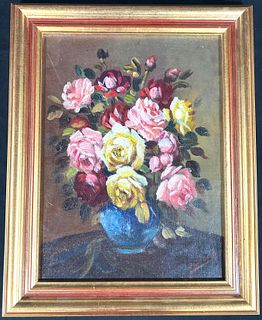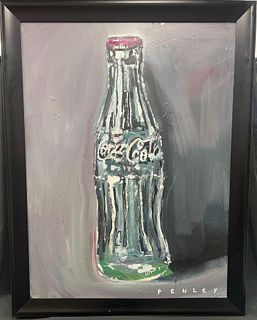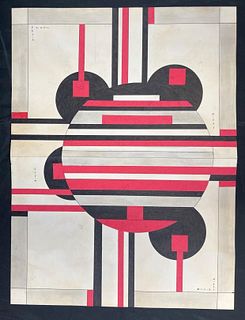Russian School of Old Believers, late 18th century. "Resurrection of Christ, Christ's Descent into Hell, with 16 hagiographic scene". Tempera on pan
Lot 112
About Seller
Setdart Auction House
Carrer Aragó 346
Barcelona
Spain
Setdart Subastas was born in 2004 and is currently the first online art auction in Spain with solidity, prestige and reliability guaranteed by our more than 60,000 users. Setdart has a young, dynamic and enterprising team ready to successfully manage the purchase and sale of art works through custom...Read more
Estimate:
EUR€4,000 - EUR€5,000
$4,081.63 - $5,102.04
Absentee vs Live bid
Two ways to bid:
- Leave a max absentee bid and the platform will bid on your behalf up to your maximum bid during the live auction.
- Bid live during the auction and your bids will be submitted real-time to the auctioneer.
Bid Increments
| Price | Bid Increment |
|---|---|
| EUR€0 | EUR€10 |
| EUR€200 | EUR€25 |
| EUR€500 | EUR€50 |
| EUR€1,000 | EUR€100 |
| EUR€3,000 | EUR€200 |
| EUR€5,000 | EUR€500 |
| EUR€10,000 | EUR€1,000 |
| EUR€20,000 | EUR€2,000 |
| EUR€50,000 | EUR€5,000 |
About Auction
By Setdart Auction House
Nov 3, 2021
Set Reminder
2021-11-03 08:00:00
2021-11-03 08:00:00
America/New_York
Bidsquare
Bidsquare : OLD MASTERS
https://www.bidsquare.com/auctions/setdart-auction-house/old-masters-7786
Setdart Auction House sofia@setdart.com
Setdart Auction House sofia@setdart.com
- Lot Description
Russian School of Old Believers, late 18th century. "Resurrection of Christ, Christ's Descent into Hell, with 16 hagiographic scene". Tempera on panel Measurements: 44 x 38 cm. Descent of Christ to hell is one of the most important representations in Christian iconography. This passage was known in Ancient Rus since the XI century, although it obtained maximum popularity in the second half of the XIV century. Iconography of this New Testament passage finally developed in the 17th century in Moscow workshops. In this period, the icon reached its maximum complexity, combining the passages of the New and Old Testament, and in turn, composing in one the scenes of the resurrection and the descent of Christ to hell. The auctioned lot presents a museum level value. The composition of the icon corresponds to a canon proper to the theme of the resurrection and the descent of Christ to hell, surrounded by 16 hagiographic scenes, which relate different Marian passages and the life of Christ, in addition to four evangelists resting in the four corners of the frame. However, what makes this icon so interesting and unique is the scene of the Trinity, located in the upper register of the icon. That typology of the Trinity is not the representation of the canonical Trinity as such, but a priori was part of Christ's own iconography. The prototype of this image was developed around the middle of the 16th century, in connection with the reconstruction of the Annunciation Cathedral of the Moscow Kremlin, which suffered a fire in 1547. This icon, along with others appearing at this historical moment, reflects the interest of the Moscow intellectual classes of the time in the rationalist approach to the Christian religion, through the more literal representation of Orthodox dogmas. All these images were developed by Metropolitan Macarius of Moscow, adored by the old believers, and Archpriest Sylvester. Despite causing much controversy, they were eventually accepted, including this version of the Trinity, better known as "The Only Son". Normally this icon was part of the composite icons, either iconostases, or venerated as an independent icon. The representation of this passage within an iconography of Christ's descent into hell is very unusual, and therefore raises the icon's value of interest. The iconography of this image is based on the liturgical texts of John the Baptist and the commentaries of the Church Fathers. The meaning of the iconography is always explained in the outer border. In the center of the composition is always found, supported by two angels, the circular mystical mandorla, with Jesus Christ, "the only Son", seated. Above him the Father God (Sebaot). In the lower part are the scenes of the triumph of death, represented by an equestrian skeleton, and the struggle of the Archangel Michael against the devil. As the link between both parts of the image is the Mother of God with the risen Jesus Christ. The Trinity type "the only Son" is an allegory of the struggle between life and death, good and evil, and represents the essence of Christ's return to heaven, and his beginning of heavenly life. It should be noted that this iconography gave rise to one of the most important Orthodox liturgical songs "The only Son, and the word of God". In addition, due to a number of details, such as the blessing with two fingers, the abundant inscriptions on the border, the eight-pointed cross, and the name of Jesus Christ written as "ICXI", etc., relate this icon to the workshops of the Russian Orthodox Old Believers.
- Shipping Info
-
In-house shipping available. Please inquire at admin@setdart.com.
-
- Buyer's Premium



 EUR
EUR CAD
CAD AUD
AUD GBP
GBP MXN
MXN HKD
HKD CNY
CNY MYR
MYR SEK
SEK SGD
SGD CHF
CHF THB
THB


















